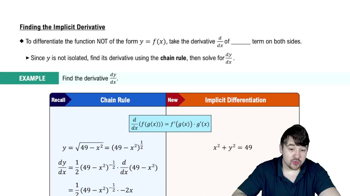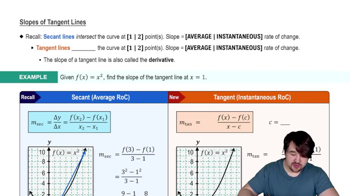Table of contents
- 0. Functions7h 52m
- Introduction to Functions16m
- Piecewise Functions10m
- Properties of Functions9m
- Common Functions1h 8m
- Transformations5m
- Combining Functions27m
- Exponent rules32m
- Exponential Functions28m
- Logarithmic Functions24m
- Properties of Logarithms34m
- Exponential & Logarithmic Equations35m
- Introduction to Trigonometric Functions38m
- Graphs of Trigonometric Functions44m
- Trigonometric Identities47m
- Inverse Trigonometric Functions48m
- 1. Limits and Continuity2h 2m
- 2. Intro to Derivatives1h 33m
- 3. Techniques of Differentiation3h 18m
- 4. Applications of Derivatives2h 38m
- 5. Graphical Applications of Derivatives6h 2m
- 6. Derivatives of Inverse, Exponential, & Logarithmic Functions2h 37m
- 7. Antiderivatives & Indefinite Integrals1h 26m
- 8. Definite Integrals4h 44m
- 9. Graphical Applications of Integrals2h 27m
- 10. Physics Applications of Integrals 2h 22m
4. Applications of Derivatives
Implicit Differentiation
Problem 3.8.64.a
Textbook Question
Vertical tangent lines
a. Determine the points where the curve x+y³−y=1 has a vertical tangent line (see Exercise 60).
 Verified step by step guidance
Verified step by step guidance1
First, understand that a vertical tangent line occurs when the derivative of the curve with respect to x is undefined, which typically happens when the denominator of the derivative is zero.
To find the derivative, start by implicitly differentiating the given equation x + y³ - y = 1 with respect to x. Remember that y is a function of x, so use the chain rule for terms involving y.
Differentiate each term: the derivative of x with respect to x is 1, the derivative of y³ with respect to x is 3y²(dy/dx), and the derivative of -y with respect to x is -(dy/dx). Set the derivative equal to zero to find where the tangent is vertical.
Combine the differentiated terms to form the equation: 1 + 3y²(dy/dx) - (dy/dx) = 0. Rearrange this to solve for dy/dx: dy/dx = -1 / (3y² - 1).
Identify the points where the denominator 3y² - 1 equals zero, as these are the points where the derivative is undefined, indicating a vertical tangent. Solve 3y² - 1 = 0 to find the values of y, and substitute back into the original equation to find the corresponding x values.
 Verified video answer for a similar problem:
Verified video answer for a similar problem:This video solution was recommended by our tutors as helpful for the problem above
Video duration:
6mPlay a video:
Was this helpful?
Key Concepts
Here are the essential concepts you must grasp in order to answer the question correctly.
Implicit Differentiation
Implicit differentiation is a technique used to find the derivative of a function defined implicitly by an equation involving both x and y. In this case, we differentiate the equation x + y³ - y = 1 with respect to x, treating y as a function of x. This allows us to find dy/dx, which is essential for determining the slope of the tangent line at any point on the curve.
Recommended video:

Finding The Implicit Derivative
Vertical Tangent Lines
A vertical tangent line occurs when the slope of the tangent line approaches infinity, which mathematically corresponds to dy/dx being undefined. This situation typically arises when the denominator of the derivative expression equals zero while the numerator does not. Identifying points where this occurs is crucial for determining the locations of vertical tangents on the curve.
Recommended video:

Slopes of Tangent Lines
Critical Points
Critical points are values of x where the derivative of a function is either zero or undefined. In the context of finding vertical tangents, we focus on points where dy/dx is undefined, as these indicate potential vertical tangents. Analyzing these points helps in understanding the behavior of the curve and identifying where the tangent lines are vertical.
Recommended video:

Critical Points

 5:14m
5:14mWatch next
Master Finding The Implicit Derivative with a bite sized video explanation from Nick
Start learningRelated Videos
Related Practice


